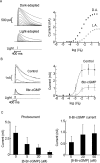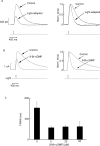Calcium-independent, cGMP-mediated light adaptation in invertebrate ciliary photoreceptors
- PMID: 15728844
- PMCID: PMC6726048
- DOI: 10.1523/JNEUROSCI.5129-04.2005
Calcium-independent, cGMP-mediated light adaptation in invertebrate ciliary photoreceptors
Abstract
Calcium is thought to be essential for adaptation of sensory receptor cells. However, the transduction cascade of hyperpolarizing, ciliary photoreceptors of the scallop does not use IP3-mediated Ca release, and the light-sensitive conductance is not measurably permeable to Ca2+. Therefore, two typical mechanisms that couple the light response to [Ca]i changes seem to be lacking in these photoreceptors. Using fluorescent indicators, we determined that, unlike in their microvillar counterparts, photostimulation of ciliary cells under voltage clamp indeed evokes no detectable change in cytosolic Ca. Notwithstanding, these cells exhibit all of the hallmarks of light adaptation, including response range compression, sensitivity shift, and photoresponse acceleration. A possible mediator of Ca-independent sensory adaptation is cGMP, the second messenger that regulates the light-sensitive conductance; cGMP and 8-bromo cGMP not only activate light-dependent K channels but also reduce the amplitude of the light response to an extent greatly in excess of that expected from simple occlusion between light and chemical stimulation. In addition, these substances accelerate the time course of the photocurrent. Tests with pharmacological antagonists suggest that protein kinase G may be a downstream effector that controls, in part, the cGMP-triggered changes in photoresponse properties during light adaptation. However, additional messengers are likely to be implicated, especially in the regulation of response kinetics. These observations suggest a novel feedback inhibition pathway for signaling sensory adaptation.
Figures







Similar articles
-
On the gating mechanisms of the light-dependent conductance in Pecten hyperpolarizing photoreceptors: does light remove inactivation in voltage-dependent K channels?J Gen Physiol. 2005 May;125(5):455-64. doi: 10.1085/jgp.200509269. Epub 2005 Apr 11. J Gen Physiol. 2005. PMID: 15824193 Free PMC article.
-
Light adaptation in Pecten hyperpolarizing photoreceptors. Insensitivity to calcium manipulations.J Gen Physiol. 1997 Mar;109(3):371-84. doi: 10.1085/jgp.109.3.371. J Gen Physiol. 1997. PMID: 9089443 Free PMC article.
-
Antagonists of the cGMP-gated conductance of vertebrate rods block the photocurrent in scallop ciliary photoreceptors.J Physiol. 1997 Apr 15;500 ( Pt 2)(Pt 2):367-78. doi: 10.1113/jphysiol.1997.sp022027. J Physiol. 1997. PMID: 9147324 Free PMC article.
-
Tuning outer segment Ca2+ homeostasis to phototransduction in rods and cones.Adv Exp Med Biol. 2002;514:179-203. doi: 10.1007/978-1-4615-0121-3_11. Adv Exp Med Biol. 2002. PMID: 12596922 Review.
-
Cyclic GMP and calcium: the internal messengers of excitation and adaptation in vertebrate photoreceptors.Vision Res. 1990;30(12):1923-48. doi: 10.1016/0042-6989(90)90013-b. Vision Res. 1990. PMID: 1962979 Review.
Cited by
-
Reduced adult stem cell fate specification led to eye reduction in cave planarians.Nat Commun. 2025 Jan 2;16(1):304. doi: 10.1038/s41467-024-54478-6. Nat Commun. 2025. PMID: 39746937 Free PMC article.
-
Phototransduction motifs and variations.Cell. 2009 Oct 16;139(2):246-64. doi: 10.1016/j.cell.2009.09.029. Cell. 2009. PMID: 19837030 Free PMC article. Review.
-
Feedforward and feedback mechanisms cooperatively regulate rapid experience-dependent response adaptation in a single thermosensory neuron type.Proc Natl Acad Sci U S A. 2024 Apr 2;121(14):e2321430121. doi: 10.1073/pnas.2321430121. Epub 2024 Mar 26. Proc Natl Acad Sci U S A. 2024. PMID: 38530893 Free PMC article.
-
Cyclic GMP and Cilia Motility.Cells. 2015 Jul 31;4(3):315-30. doi: 10.3390/cells4030315. Cells. 2015. PMID: 26264028 Free PMC article. Review.
-
Structure of cone photoreceptors.Prog Retin Eye Res. 2009 Jul;28(4):289-302. doi: 10.1016/j.preteyeres.2009.05.003. Epub 2009 Jun 6. Prog Retin Eye Res. 2009. PMID: 19501669 Free PMC article. Review.
References
-
- Beavo J (1995) Cyclic nucleotide phosphodiesterases: functional implications of multiple isoforms. Physiol Rev 75: 725-748. - PubMed
Publication types
MeSH terms
Substances
Grants and funding
LinkOut - more resources
Full Text Sources
Miscellaneous
